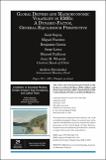| dc.contributor.author | Bajraj, Gent | |
| dc.contributor.author | Fuentes D., Miguel | |
| dc.contributor.author | García S., Benjamín | |
| dc.contributor.author | Lorca, Jorge | |
| dc.contributor.author | Paillacar, Manuel | |
| dc.contributor.author | Wlasiuk, Juan M. | |
| dc.contributor.author | Fernández, Andrés | |
| dc.date.accessioned | 2023-08-03T17:17:38Z | |
| dc.date.available | 2023-08-03T17:17:38Z | |
| dc.date.issued | 2023-08-09 | |
| dc.identifier.isbn | 9789567421718 | |
| dc.identifier.isbn | 9789567421725 (digital) | |
| dc.identifier.issn | 0717-6686 (Series on Central Banking, Analysis, and Economic Policies) | |
| dc.identifier.uri | https://hdl.handle.net/20.500.12580/7506 | |
| dc.description | A common view held by academics as well as policymakers assigns an important role to global factors as drivers of fluctuations in economic activity in emerging market economies (EMEs). This follows naturally from the fact that these economies are often small and open to trade in global goods and capital markets, which makes them vulnerable to shocks in these markets. However, the nature of these global forces as well as their transmission mechanism into EMEs continues to be debated and is the subject of an active research area in international macroeconomics. While an influential view postulates a financial origin in the form of a global financial cycle (Miranda-Agrippino and Rey, 2020), others have argued in favor of alternative global forces in the form of fluctuations in commodity prices (Fernández and others, 2017, 2018, 2020), changes in sovereign risks (Longstaff and others, 2011; Aguiar and others, 2016), and a common growth factor among EMEs (Claessens and others, 2012). | es |
| dc.description.abstract | A common view held by academics as well as policymakers assigns an important role to global factors as drivers of fluctuations in economic activity in emerging market economies (EMEs). This follows naturally from the fact that these economies are often small and open to trade in global goods and capital markets, which makes them vulnerable to shocks in these markets. However, the nature of these global forces as well as their transmission mechanism into EMEs continues to be debated and is the subject of an active research area in international macroeconomics. While an influential view postulates a financial origin in the form of a global financial cycle (Miranda-Agrippino and Rey, 2020), others have argued in favor of alternative global forces in the form of fluctuations in commodity prices (Fernández and others, 2017, 2018, 2020), changes in sovereign risks (Longstaff and others, 2011; Aguiar and others, 2016), and a common growth factor among EMEs (Claessens and others, 2012). | es |
| dc.format | .pdf | |
| dc.format.extent | Sección o Parte de un Documento | |
| dc.format.medium | p. 111-158 | |
| dc.language.iso | en | es |
| dc.publisher | Banco Central de Chile | es |
| dc.relation.ispartofseries | Series on Central Banking Analysis and Economic Policies; no. 29 | |
| dc.rights | Attribution-NonCommercial-NoDerivs 3.0 Chile | * |
| dc.rights.uri | http://creativecommons.org/licenses/by-nc-nd/3.0/cl/ | * |
| dc.title | Global drivers and macroeconomic volatility in EMEs: a dynamic-factor, general-equilibrium perspective | es |
| dc.type.doc | Artículo | |


